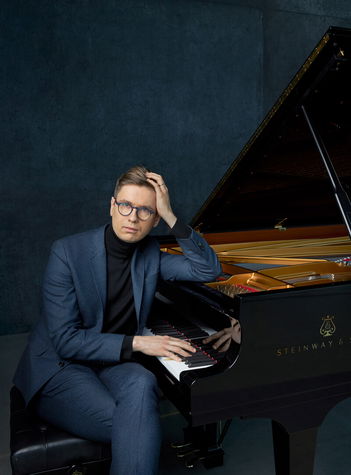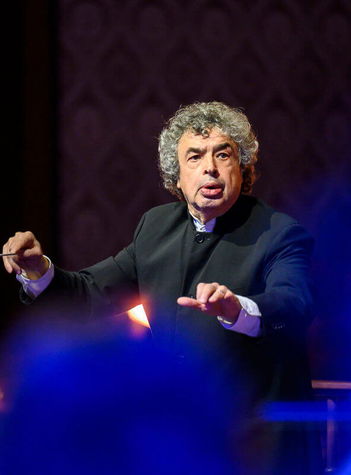Programme
Robert Schumann
Piano Concerto in A minor, Op. 54
Dmitri Shostakovich
Symphony No. 11 in G minor, Op. 103, “The Year 1905”
Secure your seat for the 2025/2026 season – presales are open.
Choose SubscriptionJust half a year after their previous residency there, the Czech Philharmonic will again give concerts at Hamburg’s Elbphilharmonie, this time with Víkingur Ólafsson in Schumann’s Piano Concerto in A minor. Semyon Bychkov will then conduct Shostakovich’s Symphony No. 11, which is a symbolic statement about the struggle between good and evil.
Robert Schumann
Piano Concerto in A minor, Op. 54
Dmitri Shostakovich
Symphony No. 11 in G minor, Op. 103, “The Year 1905”
Víkingur Ólafsson piano
Semyon Bychkov conductor
Czech Philharmonic

Víkingur Ólafsson piano

The gifts of the Icelandic pianist Víkingur Ólafsson include perfect pitch and the phenomenon of musical synaesthesia (he “hears” colours). In recent years, he has earned recognition as the world’s “new superstar of classical piano”, as the Daily Telegraph has called him. Critics acclaim his exceptional technical skill and boundless virtuosity, but above all they emphasise his innovative approach to musical interpretation, thanks to which his has been nicknamed “Iceland’s Glenn Gould” (as he was first called by the New York Times). Like Gould, Ólafsson is able to see even very familiar works with new eyes, find their hidden qualities, and arrive at conceptions that are entirely new and yet natural and sensitive.
He demonstrated this most recently with a new CD of Bach’s Goldberg Variations, issued by Deutsche Grammophon in October 2023. “I have dreamed of recording this work for 25 years” says Ólafsson, who devoted an entire concert season to this already successful album, presenting his original interpretation of that masterpiece live on a world tour appearing on six continents to perform at such halls as Carnegie Hall, Vienna’s Konzerthaus, the Zurich Tonhalle, the Philharmonie de Paris, Tokyo’s Suntory Hall, and Prague’s Rudolfinum.
Already in the past, his mastery earned him many awards, such as the title Artist of the Year 2019 awarded by the magazine Gramophone, and his recordings twice earned him the Opus Klassik prize and Album of the Year 2019 from the BBC Music Magazine. Among his most popular albums with the critics and the public, which he recorded on the Deutsche Grammophon label, have been Philip Glass Piano Works (2017), Johann Sebastian Bach (2018), Debussy – Rameau (2020), and Mozart & Contemporaries (2021).
Born in Reykjavik, he got his start at the piano under his mother’s guidance. “As a child, I saw the piano as a toy,” admits Ólafsson, adding that he has been able to preserve that playful approach to some extent not only as a student at the Juilliard School, but even to this day.
Semyon Bychkov conductor

In addition to conducting at Prague’s Rudolfinum, Semyon Bychkov and the Czech Philharmonic in the 2023/2024 season, took the all Dvořák programmes to Korea and across Japan with three concerts at Tokyo’s famed Suntory Hall. In spring, an extensive European tour took the programmes to Spain, Austria, Germany, Belgium, and France and, at the end of year 2024, the Year of Czech Music culminated with three concerts at Carnegie Hall in New York.
Among the significant joint achievements of Semyon Bychkov and the Czech Philharmonic is the release of a 7-CD box set devoted to Tchaikovsky’s symphonic repertoire and a series of international residencies. In 2024, Semjon Byčkov with the Czech Philharmonic concentrated on recording Czech music – a CD was released with Bedřich Smetanaʼs My Homeland and Antonín Dvořákʼs last three symphonies and ouvertures.
Bychkovʼs repertoire spans four centuries. His highly anticipated performances are a unique combination of innate musicality and rigorous Russian pedagogy. In addition to guest engagements with the world’s major orchestras and opera houses, Bychkov holds honorary titles with the BBC Symphony Orchestra – with whom he appears annually at the BBC Proms – and the Royal Academy of Music, who awarded him an Honorary Doctorate in July 2022. Bychkov was named “Conductor of the Year” by the International Opera Awards in 2015 and, by Musical America in 2022.
Bychkov began recording in 1986 and released discs with the Berlin Philharmonic, Bavarian Radio, Royal Concertgebouw, Philharmonia Orchestra and London Philharmonic for Philips. Subsequently a series of benchmark recordings with WDR Symphony Orchestra Cologne featured Brahms, Mahler, Rachmaninov, Shostakovich, Strauss, Verdi, Glanert and Höller. Bychkov’s 1993 recording of Tchaikovsky’s Eugene Onegin with the Orchestre de Paris continues to win awards, most recently the Gramophone Collection 2021; Wagner’s Lohengrin was BBC Music Magazine’s Record of the Year (2010); and Schmidt’s Symphony No. 2 with the Vienna Philharmonic was BBC Music Magazine’s Record of the Month (2018).
Semyon Bychkov has one foot firmly in the culture of the East and the other in the West. Born in St Petersburg in 1952, he studied at the Leningrad Conservatory with the legendary Ilya Musin. Denied his prize of conducting the Leningrad Philharmonic, Bychkov emigrated to the United States in 1975 and, has lived in Europe since the mid-1980’s. In 1989, the same year he was named Music Director of the Orchestre de Paris, Bychkov returned to the former Soviet Union as the St Petersburg Philharmonic’s Principal Guest Conductor. He was appointed Chief Conductor of the WDR Symphony Orchestra (1997) and Chief Conductor of Dresden Semperoper (1998).
Robert Schumann
Piano Concerto in A minor, Op. 54
Allegro affettuoso
Intermezzo: Andantino grazioso
Allegro vivace
Piano Concerto in A minor, Op. 54 is the only piano concerto by Robert Schumann. It came into being in a rather complicated way. In 1841 Schumann composed Fantasy (Phantasie) in A minor for Piano and Orchestra, but publishers and concert agents did not show as much interest in it as the composer had hoped. Four years later (partly at the urging of his wife, piano virtuoso Clara Schumann), he decided to expand it into a piano concerto. The Fantasy became the first movement, to which Schumann added second and third movements – Intermezzo and Allegro vivace. The complete work was premiered on 1 January 1846 by Clara Schumann as a soloist and the Leipzig Gewandhaus Orchestra, conducted by Ferdinand Hiller, to whom Schumann dedicated the work.
In comparison to other piano concertos of the time, Schumann’s concerto is instantly recognized as having an orchestral character. He himself wrote about it in a letter to his wife: “I have already told you about my concerto: it is a cross between a symphony, a concerto, and a grand sonata. It is clear that I cannot write a concerto for the virtuoso; I must think of something else.” The piano part together with the orchestra forms a closely interconnected whole. Listeners and critics, who were accustomed to virtuoso pieces in which the orchestra usually played only an accompanying role, greatly appreciated the concerto. But there were also those like Franz Liszt, who described the work as “a piano concerto without a piano”.
From the very beginning, the first movement is characterized by sharp changes of tempos and moods. The orchestra storms in, and this is followed by descending cascades of piano chords contrasted with a mournful melody sung by oboes, immediately repeated by the piano. The opening theme is the main building material of the whole movement. The monumental cadenza was written by Schumann himself. The brief middle movement (Intermezzo: Andante grazioso) is a lyrical dialogue between the piano and orchestra. The soloist again presents the main theme of the first movement, which moves without pause into the final movement. The energetic Allegro vivace produces a triumphant and joyful atmosphere and is characterized by a number of impressive rhythmic experiments.
Dmitri Shostakovich
Symphony No. 11 in G minor, Op. 103, “The Year 1905”
In September 1956 Dmitri Shostakovich celebrated his 50th birthday. He was considered the greatest symphonist of his time and was beginning to take stock. “I think that many things repeat themselves in Russian history. Of course the same event can’t repeat itself exactly, there must be differences, but many things are repeated nevertheless. People think and act similarly in many things… I wanted to show this recurrence in the Eleventh Symphony. I wrote it in 1957 and it deals with contemporary themes even though it’s called “1905”. It is about the people who have stopped believing because the cup of evil has run over. That is how the impressions of my childhood and my adult life come together.” Shostakovich himself was not witness of the bloody suppression of the 1905 St Petersburg uprising, but his family discussed this event all the time. He personally experienced the October Revolution of 1917, whose 40th anniversary had just been celebrated in 1957, and throughout his life he also felt its consequences: bullying and injustice on the one hand, and bombastic tributes and platitudes on the other. He was also constantly confronted with the regime that the 1917 Revolution had established, by which he was attacked and dragged under.
Symphony No. 11 in G minor, Op. 103, was written in 1957 during Shostakovich’s summer stay in Komarovo near what was then Leningrad. Two themes run through the entire work – the theme introduced by the string section at the beginning of the symphony and, in contrast, the ominous timpani strokes. These leitmotifs, which constantly undergo a transformation, symbolize the historical repetition of events mentioned by the composer over the course of four movements played without a pause. Other elements include quotations from 19th-century political songs – songs of the revolutionary year 1905, as well as from Shostakovich’s other compositions. The first movement, introduced by the two contrasting themes of strings and timpani, features a melody of the song “Slushay!” (Listen!) from 1864, followed by “Arrestant” (The Prisoner) from 1857. In the second movement Shostakovich has incorporated melodies from his Ten Choruses on Texts by Revolutionary Poets from 1951; they are gradually escalating into sharp marching rhythms. The uprising breaks out, is defeated, and a deathlike silence reigns outside the Winter Palace. The third movement is a symbolic remembrance of the fallen victims, featuring the well-known funeral march of the Russian revolutionaries “You Fell Victim to a Fateful Struggle” and quotes from other revolutionary songs such as “Baikal”, “'Boldly on We March, Comrades!” and “Welcome, Free Speech”. A new revolution sprouts out of the grief for the dead, and it spreads with the other songs included in the fourth movement. The coda, again with the motif of Palace Square, anticipates a new bloodshed and warns against it.
The symphony premiered on 30 October 1957 in Moscow under Natan Rakhlin. Understandably, it was met with mixed reactions. Party leaders ranked it among the exemplary works of Socialist Realism and honored the composer with the Lenin Prize, but in circles that had already begun to shake off the chains of demagoguery it was regarded as a libation and, as far as its artistic value was concerned, as illustrative film music. After another 50 years, many details of the composer’s complicated life, sandwiched between the millstones of constant party criticism and his own convictions as an artist and human being, are now known. The symphony is now seen in the spirit which Shostakovich himself suggested – as a manifestation of the strangely turning wheel of fate, which returns many moments of development to the starting point from which humanity sets out each time to find anew the justification for its existence.
Just half a year after their previous residency there, the Czech Philharmonic will again give concerts at Hamburg’s Elbphilharmonie, this time with Víkingur Ólafsson in Schumann’s Piano Concerto in A minor. Semyon Bychkov will then conduct Shostakovich’s Symphony No. 11, which is a symbolic statement about the struggle between good and evil.